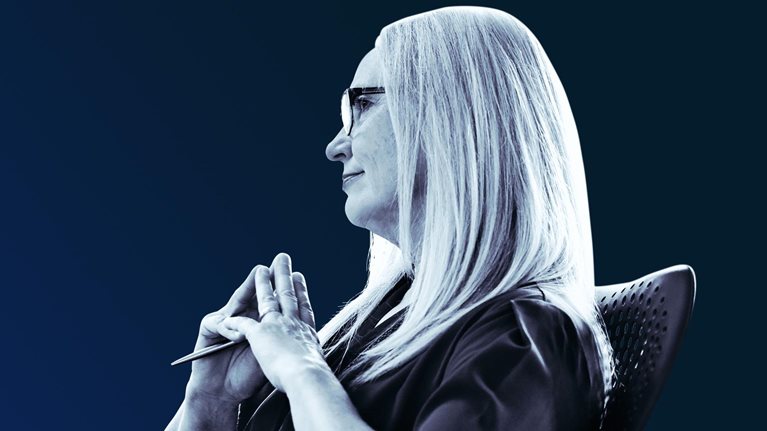“When will this be over?” This question—and the current waiting period—are top of mind for leaders everywhere as the combination of COVID-19, economic uncertainty, and social unrest continues to fuel a pervasive sense of fatigue and disillusionment in organizations around the world. At the same time, many leaders recognize this as a unique moment to be bold, reinvent, and transform—a chance to infuse new hope and energy into the organization, outperform competitors, and “win on the recovery.”
As a veteran of multiple extended deployments aboard nuclear submarines, Admiral John Richardson is no stranger to leading through long-term crises with prolonged uncertainty. Drawing on that and other experiences from his distinguished naval career, the retired four-star admiral and former chief of naval operations recently joined McKinsey’s Aaron De Smet, Daniel Pacthod, Annie-Lou St-Amant, Bob Sternfels, and Tiffany Vogel for a wide-ranging discussion about how leaders can better manage their energy during a crisis, anticipate problems in their teams, and nurture the kind of self-supporting, self-reinforcing dynamic that binds groups together during uncertain times. Condensed and edited excerpts from their October 21, 2020, conversation follow.
The Quarterly: Many leaders we talk with say that their people—especially their top talent—are working more hours; they’re taking fewer breaks; their teams are outright exhausted. Their people have been going from one sprint to the next, thinking, OK, we’ll get to steady state soon. It may not be normal, but it will be a steady state. What do you tell leaders who seem to be sprinting in the context of a marathon?
Adm. John Richardson: In some cases, leaders may have to start with an admission to themselves and to their teams: we got started on a bad set of assumptions. We may have thought that this was going to be a relatively temporary departure and that we would just kind of toughen up, survive this thing, and then go back to normal. And what we’re finding is that it wasn’t as temporary as we thought; it’s more of a departure than we anticipated.
Leaders may have to move to a mindset that’s focused not only on landing at a new normal, but also toward a mindset that recognizes that this is where we are for the foreseeable future. It’s hard to predict when conditions will change, and so success depends on managing the energy we have and conserving it for the long haul.
The stakes are really high, and when the stakes are high, many leaders naturally tend to feel they have to be there all the time, to make all the decisions. But if you can’t conserve your energy, you’re in trouble. That’s when you start making big mistakes.
The stakes are really high, and when the stakes are high, many leaders naturally tend to feel they have to be there all the time, to make all the decisions. But if you can’t conserve your energy, you’re in trouble.
The Quarterly: How do you avoid that as a leader?
Adm. John Richardson: I hope you’ll forgive me if I use a naval analogy—it’s my upbringing. [Laughs.] The ship captain’s got to recognize that they can’t be the single-point safety 24/7; you have to build a team in which you have confidence and that you trust—highly trained people that you can delegate to. You can’t do everything alone.
There’s a parallel here to submarine warfare. Many navies in the world operate diesel submarines; very few operate nuclear submarines. Diesel submarines have smaller crews, and the captain has a much larger role in running the submarine—they’re the only person who legitimately knows how to fight the boat. So if you want to take on a diesel submarine, you structure your approach on leveraging a key advantage—the long-term sustainability of your nuclear submarine’s talented crew. And you focus on the diesel boat’s weakest point—their “single-point safe” captain. You just keep that person in the hot seat until they break down—mentally or physically—and make a mistake. The point being, don’t make yourself indispensable. You’re valuable as a leader, but you’re also vulnerable as a leader, and your team will suffer if you’re truly the only person who can make all the decisions.
Ultimately, leaders must not only manage and conserve their own energy, but also focus on managing their teams’ overall energy. They must balance the load, structuring teams so that the right expertise and capacity are distributed. Whether it’s a ship or a business, each level of the organization should have a good sense of the capabilities, strengths, and limitations of their team. This allows the leader to structure for long-term performance and resilience. You’re going to need people who can step in while others get some recovery time. Who are those trusted people? Sooner or later, everyone needs a break, time to refresh.
It’s the exceptional team that self-identifies their problems. Fostering an authentic curiosity to find and fix problems helps a lot. But it also helps to build in some oversight processes.
The Quarterly: What’s the solution when leaders are clearly exhausted but—as our research shows—resist taking a break?
Adm. John Richardson: When I was chief of naval operations, we gathered the senior leadership together to discuss the importance of taking a real break. The science is clear! Then we made it a policy that everybody would take 10–14 continuous days of vacation each year—off the grid. And we monitored that closely. So, come August, if a leader hadn’t taken their days, we had a pretty serious discussion about why not, and when would a break be scheduled before December? And of course, to enable this, it’s not just about the one person—it requires that you prepare and empower your team so you can step away for 14 days and the wheels won’t come off. I led by example here, taking my time off as well!
Recovery is essential to mission effectiveness. That must include both taking time off to reenergize and to have the team and structure in place so that this time off can be protected and the mission will continue. And what works for the boss works for the team—they also need to be responsible for ensuring that their teams take time off. Without these breaks, fatigue sets in, decisions deteriorate, inefficiency increases, and performance drops. We need to build a more sustainable approach.
I recognize this can be hard, and these types of ideas don’t come naturally to a business that has run at a certain kind of rhythm for years and now is confronted with a crisis like [the pandemic]. It’s hard to step back and recognize the situation you’re in—let alone restructure your team and the way you work—while staying in stride as you keep focusing on the mission.
As a leader, make a point of being present, being attuned to your team, and really talking to them and learning about what they’re going through. In the navy, we call this ‘walking the deck plates.’
The Quarterly: Can you talk more about the mindset that’s needed for leaders—and teams—to get there? What’s the unlock? Is it the sheer exhaustion that allows leaders to finally move on some of these major team shifts or other changes? Is it acceptance of the broader context?
Adm. John Richardson: Stoic acceptance of the situation is crucial. It’s important to accept that this situation is going to be long term. We don’t know what the end will look like or when it will come. But not everything is unknown. It’s possible to set personal and team goals, and work to achieve those goals. Two-way communication across the team is super important and may not be as “natural” as it was before. Leaders must work harder to keep the team connected and together. Those habits, and others that are within our span of control, can help retain or even strengthen the agility that will allow the team to respond to conditions as they change—and have the energy to adapt accordingly.
The Quarterly: As a leader, how do you know when your team is having problems? What interventions can you take?
Adm. John Richardson: It’s the exceptional team that self-identifies their problems. Fostering an authentic curiosity to find and fix problems helps a lot. But it also helps to build in some oversight processes. Not the type of oversight against a performance plan—that serves an important purpose, but these are different sorts of problems. Beneficial, more gentle oversight can be more effective—soft, subjective assessments of a person’s or team’s emotional state, not hard-core, more quantitative assessments. And it’s harder over a video teleconference.
As a leader, make a point of being present, being attuned to your team, and really talking to them and learning about what they’re going through. In the navy, we call this “walking the deck plates”; get away from your desk and talk to your people—physically, if possible, or virtually. Empathy matters a lot too: an approachable, empathetic leader has a special kind of magic.
That said, it’s not just you—it’s a 360-degree approach: your superiors, your peers, and your subordinates can all contribute to your understanding of how things are going. When I was commanding a submarine, one of my most important partners in command was what we call the “chief of the boat”—the COB. These are quite senior men and women, they have all played “line” roles, and they’re part of the command structure—100 percent access to the captain. My COB spoke directly to me for the crew, he had a finger on their pulse, represented them to me, and me to them. I rarely went anywhere without my COB. And for any success that the ship had, I’d give the chief of the boat 95 percent of the credit.
There’s tremendous strength in team values when setting and achieving goals under stress. Our shared values are particularly important in times of uncertainty—they can unite and strengthen us, and provide something that we can be certain about.
The Quarterly: What other practices have you seen to be effective in helping people cope with highly uncertain times?
Adm. John Richardson: I think there’s a lot of value in setting goals and establishing a plan to achieve those goals. The routine and discipline necessary to achieve them builds resilience—and goals lend a structure and sanity to an environment that could be highly unstructured, even chaotic. Setting goals works equally well for individuals and for teams. When the ship would prepare and leave for an underway deployment, for example, leaders would encourage people to set some goals for themselves to accomplish during the underway period.
Perhaps this would be a health or fitness goal—getting in better shape—and measuring daily progress toward achieving it.
We also stressed their professional goals. Perhaps it’s reaching a certain level of qualification or getting an additional certification. That’s on-the-job stuff, so they can spend time doing that. And their superiors and their team can assist them in helping them qualify.
One thing that goals allow is a sense of control—at the team level, you can say: “OK, this part we know. We want to achieve these particular goals. They’re consistent with our values, they’re measurable, and they won’t distract us or detract energy from where we want to go. So let’s set up some structure to achieve them.” And then when the team achieves a goal—celebrate it. Hey, that’s a positive! It’s energizing! Then, it’s time to think about the next goal!
This type of activity also fosters collaboration—and focusing on short-term, achievable goals helps colleagues and teams regenerate their energy and regain a sense of control.
There’s tremendous strength in team values when setting and achieving goals under stress. Our shared values are particularly important in times of uncertainty—they can unite and strengthen us, and provide something that we can be certain about.
The Quarterly: So it’s about tying values to personal goals, and then using goal setting to reinforce those values?
Adm. John Richardson: Exactly. It becomes a coherent whole—self-reinforcing and self-supporting. We’re a lot stronger together than we are individually. And our goal should be consistent with our mission or purpose, executed consistently with our values, and everyone—right down to the individual—is committed to achieving it.


